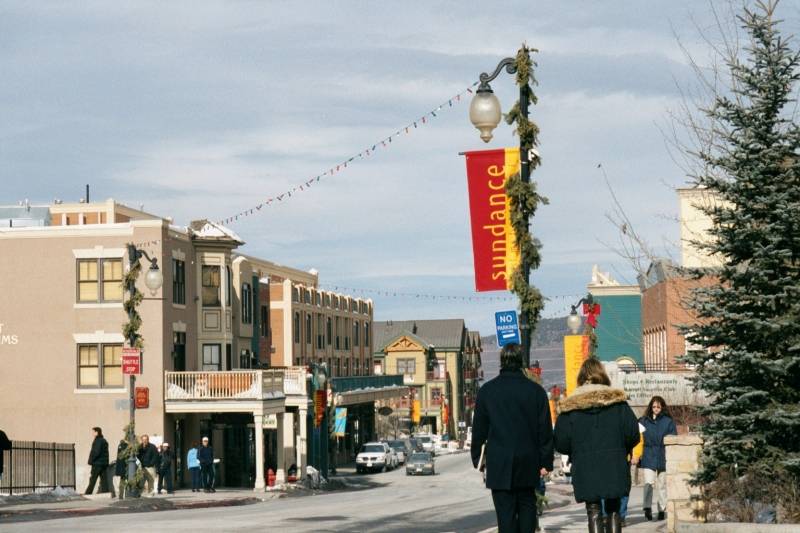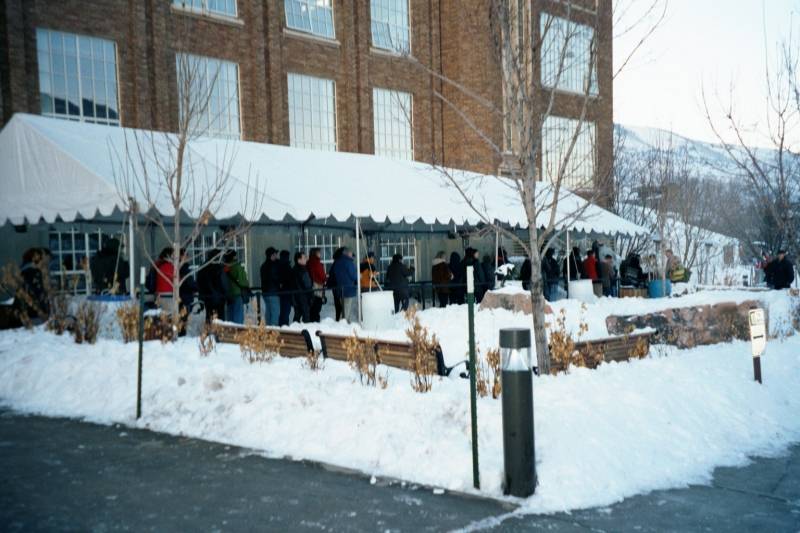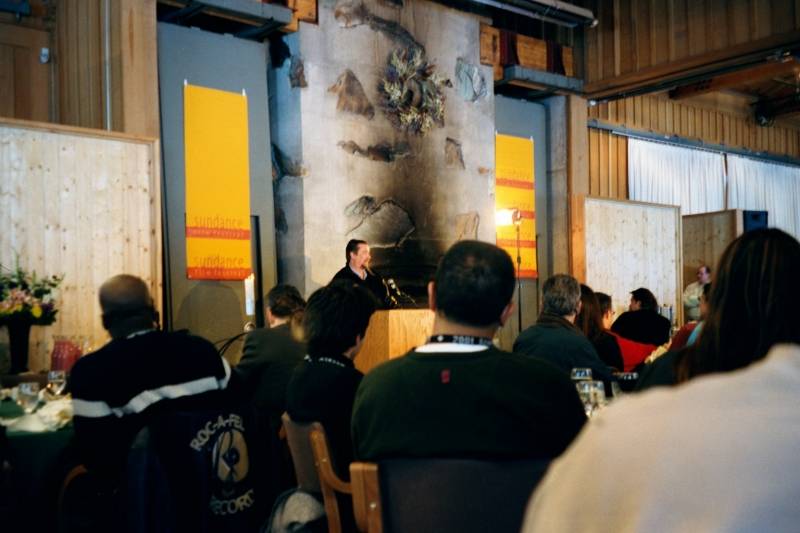Last week, the annual Sundance Film Festival took place in Park City, Utah. As far as American film festivals go, Sundance is the big daddy of them all. Every independent filmmaker, and I do mean every single one, hopes (and prays) to secure one of the few coveted screening slots at Sundance. But with the exponential growth of independent filmmakers over the past decade, the odds of getting the call from Sundance are, well, not good.
Once upon a time, film festivals were a great way for filmmakers to get their films seen. Today, film festivals are mostly a great way for filmmakers to go broke. Festivals now are innundated with submissions — along with the handy submission fees, thank you very much — far beyond what is even humanly possible to review. Little-known festivals, in the middle of nowhere, are getting five to six hundred submissions, and for the big name festivals, well, forget about it. I read one article where the author claimed that if you submit a film and pay the submission fee during the open call for a big festival, you already aren’t getting in. It’s completely turned into an insider’s game.
But it wasn’t always that way. I know. Because twelve years ago, I submitted a film during the open cattle call from Sundance. Months later, on a cold December evening, the phone rang in my kitchen. I looked down at the caller ID, and there it was: “Sundance.” (Take note kids: they don’t call you to tell you you’ve been rejected). I was in. Me, a nobody from nowhere.
Every year at this time, I fondly remember my one and only Sundance experience. Here’s how it was. For a nobody, from nowhere.
My Sundance Diary
By Jay Rosenstein
Thursday, 1/18/01 – morning
After another sleepless night (don’t ask), I settle into the American Eagle shuttle with my usual routine: a lower lumbar support pillow on my seat, a too heavy carry-on bag at my feet, and my all important Chicago Sun-Times in my lap.
It’s the usual Sun-Times fare — the Bulls stink, another friend of Gov. Ryan going to jail — until I hit Roger Ebert’s column. It’s a preview of the Sundance Film Festival. My heart beats faster; this year, for the first time, I’m going to be there too.
Ebert describes the Sundance experience as an, “inconvenient location, lousy weather, overcrowded screening facilities, municipal hostility, and a ten-day lineup of films that in some cases will never be heard of again.”
My anticipation grows.
Thursday, 1/18/01 – afternoon
I run into Roger Ebert himself at baggage claim in the Salt Lake City airport. He’s dressed in sweats, and wears the expression of someone on his way to the dentist for a root canal. Naturally, I approach him.
I tell him it’s my first time at Sundance, and ask for his advice. “Don’t go to any of the parties,” he answers. “There’s always too many people, too much smoke, and not nearly enough food. And don’t trust the shuttle buses. They’re always late.”
My anticipation grows.

Thursday, 1/18/01 – evening
After waiting over an hour for the shuttle to Park City (Roger was right!), I finally arrive at Sundance headquarters lugging my bags and wheezing like any Midwestern asthmatic would at 7,000 feet above sea level.
I get in line to talk to the coordinator for short films. Right in front of me is director Penelope Spheeris, best known for having directed Wayne’s World. How cool is that?
I check in and ask how I can get to my hotel. A driver named Helmut (from Chicago) is dispatched to drive me. He picks me up in a brand new Mercedes.
Over the past few years many independent filmmakers have been complaining that Sundance has sold out to Hollywood and corporate America. That may be true, but today I am perfectly happy getting chauffeured to my hotel in a brand new Mercedes.
Friday, 1/19/01 – morning
I rush out early to catch two shuttle buses to get to my film’s first screening. It’s 8:30 a.m., opening day. If it isn’t bad enough that my film is being shown in a venue called “the Library,” I have visions of five people showing up at this ridiculous hour. But as the bus pulls up, I see a line of people already waiting outside to get in. Now I’m nervous.
I walk in to meet Trevor Groth, the man who selects all the short films for the festival. My film is a short, and there are several collections of shorts grouped together as programs and shown during the festival.
Trevor introduces me to two of the other filmmakers in my program. One of them, Scott Coffey, looks familiar to me. It turns out he’s an actor from L.A. and has been in lots of what he calls “teen films.” He rattles off the list, and I’ve seen a few.
“So,” he asks me, “are you from New York or L.A.?”
Well…
Later in the festival, Scott will introduce me to the star of his short film, a tiny, drop-dead gorgeous woman named Naomi Watts.
I’m sure she remembers meeting me too.
Friday, 1/19/01 – morning – The Screening

So this is it. My first screening at the Sundance Film Festival. My film is second on the program, and I am incredibly nervous. The theater is almost packed, probably more than 200 people in the audience. After the first film, I stare at the black screen and fidget in my seat. I am frightened to death. It seems to take forever for my film to begin.
My film starts, and some people laugh immediately at my father’s first on-screen comment. A good sign. As the film goes on, more and more people start laughing. They’re into it. When my mother says in the film “…this is your mother, Marion Rosenstein,” the entire room practically explodes with laughter. But gradually, as the real subject of the film is revealed — my mother’s dementia — the laughs slow down and the audience becomes silent. They get it.
Finally, when the film finishes, I get an enthusiastic and sustained applause that lasts through the entire credits. I’m elated. It went great.
After the program is over, I wonder if anyone will want to talk with me, especially since one of the later films, Ari Gold’s Helicopter is absolutely brilliant. As I slowly walk out, I’m approached by a woman who says she loved my film and it made her cry. Then a second woman says the same thing.
Moments later, I’m approached by a dark-haired woman who hands me her card. She says she’s interested. I look at the card: Kelly Devine, Acquisitions Director, Independent Film Channel.
Life is good.
Friday, 1/19/01 – evening
I’m at a crowded screening of the documentary Go Tigers (I hate it). A woman walks in with her two friends. She spots the open seat next to me and takes it. We chat. She’s in acquisitions for TNT. She hands me her card.
“Send me a tape,” she says.
Sundance.
Saturday, 1/20/01 – morning
At breakfast at my hotel, I see the old actor who played the father in Breaking Away and Sixteen Candles eating alone. At the next table, also eating alone, is the short, bald actor with the weird voice who played the teacher in Clueless.
I guess they put up all the quirky-looking old actors at my hotel. Not sure what that says about me.
Or perhaps, I am sure.
Saturday, 1/20/01 – morning
I leave breakfast and head for the festival headquarters. Today is the big day for all the Sundance directors: We’re going to be driven by bus two hours away to the Sundance Institute, where we will have brunch with Robert Redford. I check my hair again in the mirror and realize it’s hopeless.
We board the two buses reserved for the trip. We talk to one another, identifying ourselves by our film titles, then chat about the usual director’s talk: distribution deals, film and tape transfers, etc. I end up sitting next to an African American filmmaker from New York who made a short called This is for You Spike (good title).
He’s a former Temple University football player and spends the whole trip telling me football stories. Even here, in the remote wilderness of Utah, I can’t seem to get away from sports.
We arrive and are marched into a large building near a ski area. At the door we are asked to show our tickets for the brunch. I wonder why they didn’t ask us for our tickets before we made the two hour bus trip. I also begin to panic and wonder what will happen if I can’t find my ticket; will I have to go back and sit in the bus? Fortunately, I find it, and they let me in.
The room is huge. There are food buffets at either end, and television lights and video cameras all around. I sit next to Doug Pray, director of Hype, a documentary about the Seattle music scene. I tell him my wife is in love with Eddie Vedder of the band Pearl Jam, who is interviewed in Doug’s film. I ask him if he’d send me an outtake from Eddie Vedder’s interview. He says no. We don’t speak again.
Finally, a silver-haired man steps onto the small stage and up to the podium set up for this event. He is one of the heads of the Sundance Institute. I start to get butterflies in my stomach; this must be Robert Redford’s introduction. I begin to wonder what he looks like in real life.
The man continues his speech, talking about Redford’s commitment to independent film and how every year he especially loves this event, the chance to meet all the directors at the festival.
But, the man continues, for the first time in the festival’s history, Robert Redford is not here. Instead he is away on location making a film. He sends his regards.
I slowly realize I will have ridden on a bus for four hours through the wilderness of rural Utah for Robert Redford’s regards.

Saturday, 1/20/01 – evening
I’m riding the festival shuttle bus, trying to time things so I can both eat and make it to a screening on time. Having lost my watch already, and unsure of the time, I turn around to ask the man behind me if he has a watch. I freeze. The man is D.A. Pennebaker, one of the most legendary documentary filmmakers of all time.
Two of Pennebaker’s classic documentaries from the 1960s, Monterey Pop and Don’t Look Back, probably have more to do with my becoming a documentary filmmaker than anything. I introduce myself. He tells me he’s heard of my name.
I don’t hear anything else for the rest of the conversation.
Saturday, 1/20/01 – evening, later
This, from the newest Entertainment Weekly magazine: “Sundance: It’s the cell phone capital of the world because indie filmmakers must stay in touch. With their parents.”
I am the only person at Sundance without a cell phone. I ask the guy behind the counter at the Holiday Village Cinema (one of the screening venues) if they have a pay phone. The reaction on his face looks as if I just asked where to find replacement parts for a Model T. I might as well have.
Eventually, he directs me outside. I stand out in the cold using the pay phone, watching dozens of people walk by using their cell phones. They all look at me strangely.
I am certain that I am the first person ever to use a pay phone at Sundance.
Sunday, 1/21/01 – afternoon
I sit down for a screening of the film Chain Camera. A woman sits down in the empty seat next to me. “What have you seen that’s good?” she asks. It is the most common conversation starter at Sundance.
We talk. It turns out she made a short film that won the Grand Jury prize last year at Slamdance, another festival that runs in Park City during the same days as Sundance. She says she has also directed other short films, all of which she sold to various companies. One of those films even screened at Cannes, the most famous film festival in the world. Because of that, she continues, she now has a script-writing job at a major Hollywood studio.
“I’m totally living the American dream right now,” she says.
“Don’t tell anyone,” I reply.
Sunday, 1/21/01 – evening
I go to a screening of We Sold Our Souls to Rock and Roll, a documentary about Ozzy Osbourne’s Ozz Fest (a quick side note: Sharon Osbourne is also at the screening, sitting a few rows behind me. I barely notice, and I barely care. But ten years later, I share this story with my eight-year-old daughter, and she thinks it’s the coolest thing in the world).
While we wait for the film to begin, I start talking with a guy behind me. He tells me he is a reporter for Entertainment Weekly. After I introduce myself, I tell him that the best film I’ve seen so far at the festival is Helicopter, by Ari Gold. He says that’s the first time ever at Sundance that a filmmaker has pitched him someone else’s film. I tell him that’s because I am from the Midwest.
I’m not really sure what that means, but after I say it, he writes down my name and contact information, then calls the next day to invite me to the private Entertainment Weekly party.
I don’t go.
Sunday, 1/21/01 – very very late
After leaving the Ozz Fest film, I get on the late-night Park City shuttle bus. My hotel is only about a quarter mile away, but I’m tired and don’t want to walk.
The driver pulls away and puts in a tape. I quickly realize I got on the right bus, but unfortunately, it is going in the wrong direction. I end up hearing the entire Doobie Brothers’ Greatest Hits album, beginning to end, before the bus finally makes it to my hotel.
I could have walked to my hotel in about ten minutes.
But then again, I love the Doobie Brothers.
Wednesday, 1/24/01 – afternoon
This afternoon I attend a panel about international distribution for documentaries. It is one of the many documentary-related panels I attend this week (a side note: I notice a beautful dark-haired woman who seems to be attending all the documentary panels too. I introduce myself and find out her name is Emily Morse. Today she hosts a radio show called “Sex With Emily” and starred in a VH1 reality show last year. I’m sure she remembers me too).
One of the panelists is Catherine Olsen from the Canadian Broadcasting Corporation. I recognize her name because a few years ago I sent her a tape of my documentary In Whose Honor?, but she turned it down for acquisition.
After the panel, I approach her, introduce myself, and remind her about my film. She says she vaguely remembers it, probably because she feels so strongly about eliminating Native American sports mascots. Given that, I ask her, would she like me to send her the tape for consideration again?
She doesn’t reply, and there is an awkward silence between us. “It’s ok if you say no,” I say, finally, trying to break the tension.
“No,” she replies.
Wednesday, 1/24/01 – early evening
I’m at the private press and director’s reception. It will be the one and only Sundance party I attend all week.
I’m approached by a Taiwanese filmmaker who I’d met earlier on one of the shuttle buses. He also has a short film in the festival.
He keeps raving about my film, telling me over and over how much he liked it. When I mention that I am leaving the festival tomorrow (Thursday), he seems shocked. He’s convinced I must stay for Saturday’s awards ceremony because my film is going to win the festival’s best short film award.
I make a mental note to consider moving to Taiwan (it doesn’t win).
Wednesday, 1/24/01 – minutes later
(Another note: after leaving the reception, in the hall, I meet two women who are a filmmaking team. One woman is short with dark hair, very Jewish, and talks non-stop, pitching their film to me. The other woman is taller and thin, wearing glasses. She doesn’t say a word and totally ignores me.
Today she is my girlfriend, and we’ve been together for five years.)
Wednesday, 1/24/01 – later in the evening
While killiing time waiting for a screening of the documentary StartUp.com (executive produced by D.A. Pennebaker, by the way), I see a clipping from yesterday’s Salt Lake Tribune posted on the wall. It’s an article highlighting some of the short films at Sundance this year. It includes a mention of my film.
The reviewer calls my film a “pithy short” and a “touching four-minute film.” Not bad. But he also says my film was made by Jay Rosenblatt, a San Francisco filmmaker who is much more famous than me.
Oh well, I think, at least they spelled the name of film right.
And Jay Rosenblatt’s name too.
Thursday, 1/25/01 – time unknown
I’m sitting on my American Eagle shuttle flight back to Champaign, still buzzing from the overwhelming Sundance experience. A passenger walks down the aisle, turns to his friend and says, “It don’t matter where you sit.” My euphoria snaps, and I realize I’m back in central Illinois.
The dream is over.








